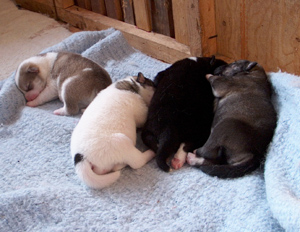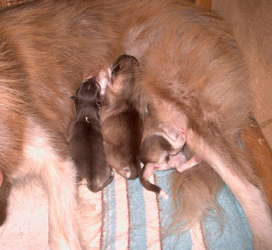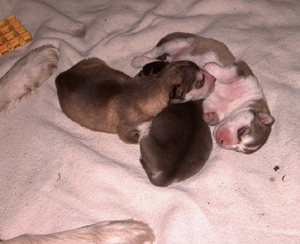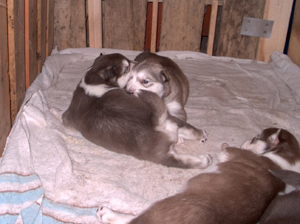Table of Contents
*
F.I.D.O.: Peter Schmidt Mikkelsen
*
A Conversation with Palle Norit
*
DNA Analysis of the Greenland Dog and the Canadian Inuit Dog
*
Pregnancy, Whelping and Pup Development in the ISD, Part 1
*
Product Review: Herculiner®
*
Tip for the Trail: Anti-fatigue Mats
*
In the News
*
Janice Howls: At the Heart of Greatness
*
IMHO: Training or Interference
Navigating This
Site
Index of articles by subject
Index
of back issues by volume number
Search The
Fan Hitch
Articles
to download and print
Ordering
Ken MacRury's Thesis
Our
comprehensive list of resources
Talk
to The
Fan Hitch
The Fan
Hitch home page
ISDI
home page
Editor's/Publisher's Statement
Editor: Sue Hamilton
Webmaster: Mark Hamilton
The Fan Hitch welcomes your letters, stories, comments and suggestions. The editorial staff reserves the right to edit submissions used for publication.
Contents of The Fan Hitch are protected by international copyright laws. No photo, drawing or text may be reproduced in any form without written consent. Webmasters please note: written consent is necessary before linking this site to yours! Please forward requests to Sue Hamilton, 55 Town Line Rd., Harwinton, Connecticut 06791, USA or mail@thefanhitch.org.
This site is dedicated to the Inuit Dog as well as related Inuit culture and traditions. It is also home to The Fan Hitch, Journal of the Inuit Sled Dog.

Pups, six days old Montcombroux photo
Pregnancy, Whelping And Pup
Development in the ISD
Part I: Breeding to Whelping
by Geneviève Montcombroux
Let me summarize the breeding and pregnancy of the ISD. At the end of the nineteen-day heat cycle, the female becomes receptive. This stage usually lasts three days. Ovulation can occur before or after this time. Pregnancy lasts sixty-three days from ovulation. Since ovulation cannot be accurately determined except by a veterinarian doing a daily cytology smear, the expected birth date falls some sixty-three days, plus or minus the number of days between the first and last mating.
The ISD bitch carries her pups very high in the rib cage. Although at five to six weeks it is possible to feel a round lump in her belly when she is resting, she does not normally show any belly growth until two weeks before birth.
As for nutrition, the bitch should be fed one-quarter more calories six weeks into the pregnancy. At seven weeks, she should be fed one-and-a-half times her normal ration. This is also the time to begin providing additional vitamins. Three weeks or so after the birth, the mother will begin to shed her coat. This is normal. She will eventually look scrawny and haggard the more weight and condition she loses. This too is normal.
At Toadhall, all my bitches whelp in the house. Purists may claim that since in the Arctic pups are born outside, breeders in southern climes should strive to replicate the harsher conditions of the North.
Historically, this picture is not accurate. Many a time, particularly in the days when the dogs were an essential part of Inuit life, the pregnant bitch gave birth inside the igloo. Sometimes, the hunter would build her a small igloo. If birth took place in the summer, the bitch might have found a cave or dug a hole, depending on the location of the camp. The hunter provided protection from predatory members of the pack. In the traditional conditions, adult males were usually good with small pups, although occasionally they tried to kill them.
When hunters were obliged to picket their dogs, they either built a shelter for the bitch at her place on the line or picketed her on her own away from the pack. As the pups grew and ventured farther afield, they invariably ran into picketed adult dogs. Most were tolerant of the pups. A few were not and attempted to kill or maim them.
When the pups are born indoors, they develop their maximum potential faster and better. They also benefit from daily interaction with the family. Outside, they only interact with their care provider once or twice a day. In summer, the pups must contend with mosquitoes, flies and ticks, and in winter, with severe cold. These are factors that mobilize the small pups’ resources to fight the insects or the cold instead of using their resources to grow.

Pups, just three hours
old
Montcombroux
photo
Some commentators maintain that it is precisely this struggle against the forces of nature that molds the character of the growing pup and weeds out those unable to withstand the punishing effects of environmental factors. More forward minded breeders realize that the stalwart character of the Inuit Dog is not nurtured by subjecting the small pup to severe conditions. The breed survived the rigors of the Arctic despite these conditions not because of them.
At nine weeks, the last week of pregnancy, the bitch should be provided with as much food as she wants. In the last week of pregnancy, she should be taken into her whelping area, so she becomes familiar with it. If the birth is to take place outside, a 20' x 20' enclosure with a 4' x 8' x 3' high house high makes a safe pen for pups and mother. Note that whelping outside, without assistance and the ability to intervene, can result in the loss of pups and mother when things go badly wrong. When a bitch whelps outside in winter, the chances for survival of the pups is much reduced. The mother can keep warm only four pups at a time. Those pups partly or totally exposed will freeze.
Even when whelping indoors, the bitch needs a sheltered birthing area. I use a 4' x 10' x 3' high enclosed area, with a roof over half of the pen area. The gate should enable the mother to leave and enter the pen by herself. As the pups grow, she needs time away from them. If the bitch is to whelp indoors, she needs to go outside to relieve herself every three hours, in addition to first thing in the morning and last thing at night. That is when the resident musher gets a lot of exercise!
It is possible to calculate the time of birth if the bitch's temperature is taken morning and evening in week nine. When the temperature drops to about 36° C (96° F), labor has started and birth could be one to six hours away. Labor can last up to thirty-six hours. Some bitches keep eating; others stop. If she shows no signs of distress (straining, holing up in the corner, not moving, for instance) then do nothing, except wait.
Many bitches whelp in the middle of the night or early morning. My theory is because that everything is quiet at that time. If the household is a quiet one, she is just as likely to whelp during the day. If she remains outside she will whelp during the night in most instances.
Refusal to eat is normal behavior when whelping is about to happen. When in the house, asking for the door and making a show of urinating, but not doing anything is also normal, caused by the downward pressure of the pups simulating the need to urinate. Some bitches walk round and round, until suddenly they stop and push, and the first pup is born. Then they normally remain in a lying position, depending on how difficult the birth is. Others lie down and wait. When the birth is imminent, she keeps licking her vaginal area.
Under the best of circumstances, the owner only needs to observe the birthing process, pick up each newborn pup and hold it while the following one arrives. The newborns should be allowed to suckle while the mother rests before the next arrival. And so on till they are all born. This is a safety measure as pups can get crushed, especially during difficult births. Praise the mother throughout the process.
While the majority of pregnancies and births are straightforward and free of complications, things can go wrong. If the pregnant bitch is straining hard and the contractions can be felt (her whole body seems to undulate) yet nothing is produced except greenish water, it is sign of trouble. Look at her vagina, if no pup can be seen, take her to the vet, quickly. If there are any signs of distress, then she should be taken to the vet for an exam and ultrasound.
If a pup is emerging but not coming out, or is being drawn back in, insert a latex-gloved finger (or at least a lubricated finger) into the vagina and pull gently. The bitch will help by licking and pushing. Talk to her in a calm voice. If you are lacking confidence you can help by pulling, sometimes you will need to pull hard, without squeezing the pup, then take mother and pups to or call in the vet.

Pups, three days
old
Montcombroux
photo
When all the pups are born and suckling, the mother will be content to lie in the nursery area. Most mothers do not eat for anything for a full day to as much as three days and do not move from the pups. Offer tempting food, anyway. I use plain roast chicken. The bitch may not even leave to urinate. Do not worry about her not urinating. The bitch's system is marvelously adapted. She will need water, and lots of it. Make it available so she does not have to move more than a foot away from her pups. She becomes very protective even when she trusts her owner. Let her rest for twenty-four hours. Then invite her outside. She will hesitate, or refuse altogether, frequently running back and forth between the door and the pups. When she does go outside, she will urinate in record time and bolt back to her litter. From the second day onward, pick up each pup in your hand but do not remove it from the nursery or even place it in your lap. The mother may try to snatch the pup back and an accident could occur. Simply stroke each pup talking to it and the mother.
A bitch whelping outside will not move from her pups for three days, particularly in the colder season. She should have water available, close enough that she can reach without moving from her nest. It might be difficult to begin handling the pups until after the mother decides to leave the litter, which she will only do for a few minutes, usually just long enough to relieve herself.
Do not let anybody, children in particular, or other dogs (or cats) anywhere near the mother and pups for five days after the birth. She will lunge aggressively toward a new face and in doing so could injure a pup. I recommend a seven-day interval, and then visitors should merely look on from the gate. Children should remain silent. The pitch of a young child's voice is similar to the squeal of a pup's and it is guaranteed to unsettle the mother. The sweetest bitch may turn aggressive.
When the pups are two weeks old, the mother usually becomes more relaxed. Nonetheless, never hand a pup to a visitor to pet. The mother will react aggressively. At no time should a visitor be allowed to crawl into the nursery.

Pups, now fourteen days
old
Montcombroux photo
In part II: Feeding the lactating bitch and pup development.